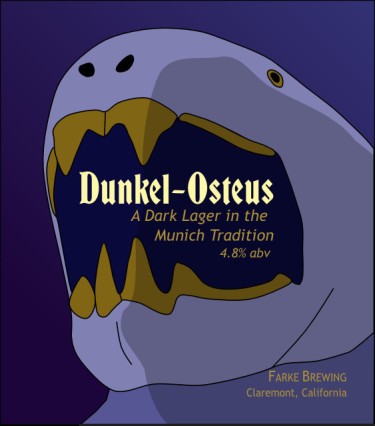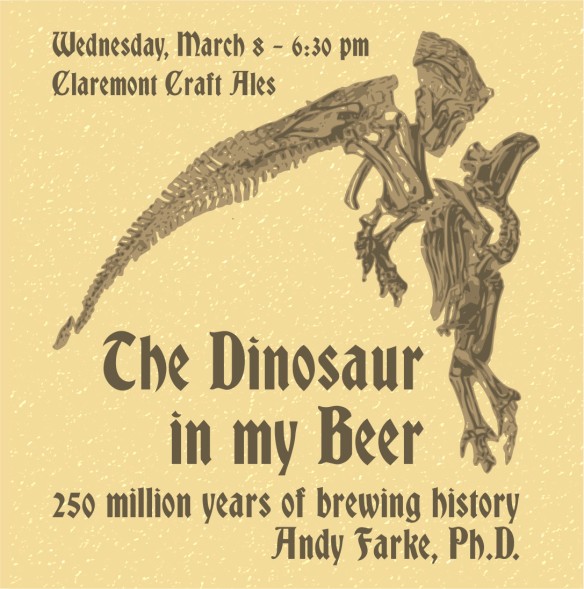 I love brewing new styles, and I also love a bad beer pun. The unholy marriage between the two: Dunkel-Osteus!
I love brewing new styles, and I also love a bad beer pun. The unholy marriage between the two: Dunkel-Osteus!
For this batch, I’m making a Munich dunkel. It’s a reasonably dark, malt-forward lager, in a style that I’ve not brewed previously. Musing over what to call this batch, I remembered a famous prehistoric fish, Dunkleosteus. Dunkel-Osteus was a match made in prehistoric pun heaven!
Dunkleosteus lived around 375 million years ago, during the Devonian (also known as “The Age of Fishes”). It was a giant animal, with sharp bony plates lining its jaws rather than teeth. The largest species were huge, clocking in at around 20 feet in length and a ton in body mass. These were top-tier marine predators, and are a popular exhibit in many museums today. Dunkleosteus and its close kin were an early side branch in vertebrate evolution–nothing exactly like them is around today. However, we humans inherited a common feature from the way-way-way-back ancestor we share with Dunkleosteus: our jaw bones! The open-and-shut jaw arrangement and the major bones that make up our mouth had their origins in some humble fish back before even Dunkleosteus (see this scientific paper on the evolutionary relationships of these organisms). Although the extent to which the jaws of Dunkleosteus and its kin are directly tied to our own has been debated, the latest evidence strongly suggests that they have the same essential bones and are based on the same genetic blueprints, with some evolutionary tweaks. So, next time you open wide for a tasty lager, think about how amazing it is that you are using some of the same skull bones that Dunkleosteus had!

A highly pruned evolutionary tree for jawed fish and kin. Everything is approximately to scale. Silhouettes via phylopic.org. Humans by Mike Keesey (public domain, right figure) and Sarah Werning (CC-BY, left figure), elephant by Mike Keesey (public domain), tyrannosaur by Emily Willoughby (CC-BY-SA), Dunkleosteus by Dmitry Bogdanov and converted to silhouette by Mike Keesey (CC-BY), tuna by Stuart Humphries (public domain).
The fossil fish Dunkleosteus was named in honor of David Dunkle, a paleontologist at the Cleveland Museum of Natural History way back in the 1950s. As such, the prehistoric organism has nothing to do with the Munich Dunkel style (and indeed, Dunkle and Dunkel are spelled differently). Nonetheless, I couldn’t pass up a good pun!
The recipe is modified slightly from a dunkel presented in Modern Homebrew Recipes, by Gordon Strong. I love the simplicity of Strong’s version–a base malt, two specialty malts, one variety of hops, and a yeast. I elected to use a single infusion mash rather than a decoction mash schedule, and upped the gravity a point or two (while still keeping it at the lower end of the style). I also replaced German Tettnang hops with American-grown Liberty, based on availability, and used dry yeast for simplicity. One major recommendations I retained from Strong’s book was to add the dark grains at vorlauf (in this case, the Carafa Special II), rather than leaving them in the mash for the whole duration. My goal was to have the Carafa just be for coloration, rather than for adding much flavor, and a short steep seemed like the best way to achieve this.
Dunkel-Osteus
- 9 lbs. Munich II malt (Weyermann)
- 5 oz. melanoidin malt (Weyermann)
- 6 oz. Carafa Special II malt (Weyermann), added at vorlauf
- 1.5 oz. Liberty hops (3.9% alpha), 60 minute boil
- 1 tsp. Fermax yeast nutrient, 10 minute boil
- 1 Whirlfloc tablet, 10 minute boil
- 2 pkg. Saflager Lager yeast (Fermentis W34/70)
Target Parameters
- 60 minute infusion mash, 154°
- 1.050 o.g., 1.013 f.g., 4.9% abv, 22 IBU, 20 SRM
Procedure
- I adjusted my water slightly, to fall within the “malty dark lager” profile in the Palmer and Kaminski water book. I used 5 gallons of Claremont tap water with 3 gallons of RO water and 5 g of calcium chloride. The resulting water profile should approximate 82 ppm Ca, 7 ppm Mg, 15 ppm Na, 31 ppm SO4, 94 ppm Cl, 131 ppm HCO3, and residual alkalinity of 44 ppm.
- I added 3.25 gallons of water to my mash tun (1 gallon of RO, 2.25 gallons of tap water, and 5 g calcium chloride), at a temperature of 172° or so. I swirled it around the mash tun for a bit, and let it cool down over a period of 5 minutes or so until it hit a temperature of 166°. I mashed in at this point, to hit a temperature of 154.5°.
- The mash cooled to around 150° after 50 minutes.
- After 60 minutes in the mash, I added 1.5 gallons of sparge water, let it sit for 10 minutes, added the dark grains, and vorlaufed before collecting the first runnings. My sparge water was made of a blend of 2 gallons RO water and the remainder with tap water. I added ~3.25 gallons of water for the second batch sparge, stirred, let it sit for 10 minutes, and collected the second runnings.
- I collected 6.5 gallons of wort, a touch below my target of 6.75. So, I added 0.25 gallons of RO water, to reach the target volume. The resulting wort gravity was 1.041–pretty much exactly on target, with an efficiency of 76%.
- I started the boil, and added the hops, Whirlfloc, and yeast nutrient per the schedule. After 60 minutes, I turned off the flame and chilled the wort down to 70°.
- Around 5.25 gallons of wort went into the fermenter, with a gravity of 1.050. It’s nice to hit the brewing targets!
- I pitched the dry yeast immediately, and put the beer in the fermentation chamber. I’ll be fermenting this at 54° for at least two weeks. I’m in no rush with this beer (there are three other beers in the queue ahead of it), so there is no urgency to do a fast lager schedule. I brewed this beer on 10 February 2017.



 I love brewing new styles, and I also love a bad beer pun. The unholy marriage between the two: Dunkel-Osteus!
I love brewing new styles, and I also love a bad beer pun. The unholy marriage between the two: Dunkel-Osteus!